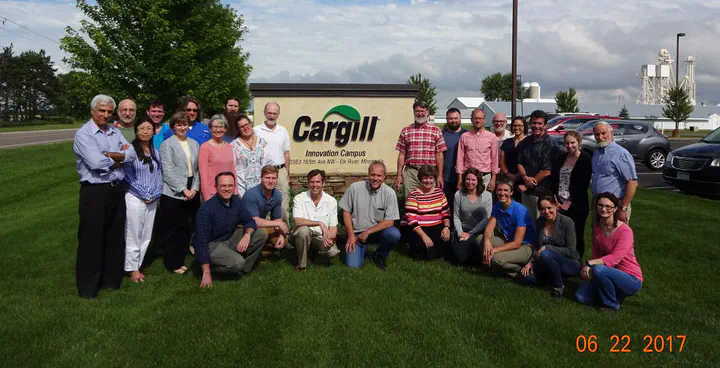2017 NCCC170 Annual Meeting
Cargill Innovation Campus, Minnesota

Thursday, June 22, 2017
8:00 AM
Registration and Check-In
8:30 AM
Welcome and Introduction
8:40 AM
The All Configurations Maximum Interaction F-test for Non-additivity and the hiddenf Package in R
Jason Osborne, Dept. of Statistics, North Carolina State University
Chris Franck, Dept. of Statistics, Virginia Polytech Institute and State University
Dennis Boos, Dept. of Statistics, North Carolina State University
Bong Choi, SAS Institute
A test is presented for a particular type of non-additivity in two-factor layouts. The term ``hidden additivity" is introduced to describe cases where levels of one factor (B) can be placed into a smaller number of groups such that the effects of the other factor (A) vary across groups but are additive with factor B effects within groups.
More...
8:45 AM
Pooling of variances: the skeleton in the mixed model closet?
Philip Dixon, Department of Statistics, Iowa State University
This talk is intended to solicit opinions and advice on an issue that I worry about intermittently: when is it appropriate to pool variances and when should that be avoided. The issue is not new: one instance is inference about the difference of means from two groups.
More...
9:20 AM
Possible Advantages of Matching Concepts in Agricultural Experiments with Blocks
Elaine Sotherden and William Bridges, Dept. of Mathematical Sciences, Clemson University
In many agricultural studies the experimental units are grouped into blocks based on covariates available when the experiment is planned. The treatments are randomly assigned to experimental units within the blocks, and the blocks are included in the model used to analyze the study.
More...
10:00 AM
Morning Break
11:00 AM
Discussion: Overview of Statistics as a Scientific Discipline and Practical Implications for the Evaluation of Faculty Excellence
William Bridges, Dept. of Mathematical Sciences, Clemson University
Walter Stroup, Dept. of Statistics, University of Nebraska - Lincoln
Nora M. Bello, Dept. of Statistics, Kansas State University
Bruce Craig, Dept. of Statistics, Purdue University
Open discussion and solicitation of opinions from the group on the working draft of two statements targeted at outlining the role of statistical consulting and interdisciplinary collaboration in the broader scientific discipline of Statistics and practical implications for evaluation of scholarship in related faculty positions.
More...
12:00 PM
Lunch
1:00 PM
Multi-Trait Genomic Selection in Plant Breeding Programs
Kelci J Miclaus, Russ D. Wolfinger, Luciano da Costa e Silva, Lauro Hose Moreira Guimaraes, Advanced Analytics R&D for the JMP Life Sciences division, SAS Institute
Predictive models that leverage genomic variability allow crop improvement programs to make large gains in efficiency and logistical resources via virtual breeding. In nearly all breeding programs there are multiple traits of interest which can be at cross-purposes.
More...
1:40 PM
The Influence of Peak GWAS Associations on Genomic Prediction Accuracy
Brian Rice and Alexander E. Lipka, Dept. of Crop Science, University of Illinois
Some of the most important agronomic crop traits of interest are complex and thus governed by many genes of small effect. The statistical models typically used in a genome-wide association study (GWAS) and genomic selection (GS) quantify the contributions of genomic markers in linkage disequilibrium with these genes to trait variation.
More...
2:10 PM
Genome Wide Association Study for Non-normally Distributed Traits: A Case Study for Stalk Lodging in Maize
Esperanza Shenstone and Alexander E. Lipka, Dept. of Crop Science, University of Illinois
The abundance of new genomic information available has increased the ability of statistical and computational tools to study the genetic basis of agricultural traits. As such, the genome-wide association study (GWAS), in which statistical tests of association are conducted between genome-wide marker sets and traits of interest, are one of the most predominant analyses used to dissect the genetic architecture of traits.
More...
2:40 PM
Afternoon Break
3:00 PM
Imputation and paired samples in microRNA profiling
John Stevens, Dept. of Mathematics and Statistics, Utah State University
microRNAs are small non-coding RNA molecules that post-transcriptionally regulate gene expression, and can play an epigenetic role in many systems. This talk will include a summary of two statistical issues that arose in a recent microRNA profiling project where most subjects provided paired samples (from both healthy and diseased tissue).
More...
3:40 PM
Metabolomics: Challenges and Success
Kathleen M Yeater, USDA-ARS-NRRC-PA
Metabolomics is defined as the comprehensive analysis of all small-molecule compounds that can be found in biological samples, such as cells, tissues or biofluids (Fiehn, 2002). Interest in this research field stems from research goals of identifying biomarkers of disease, or quantifying biochemical phenotypes.
More...
4:20 PM
Group Discussion
5:00 PM
Adjourn
Friday, June 23, 2017
9:00 AM
Business Meeting
10:00 AM
Site visit: Research farms at Cargill Animal Nutrition
12:00 PM
Adjourn